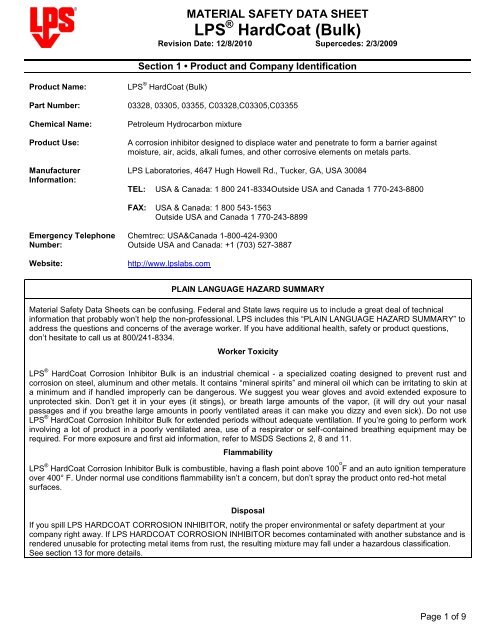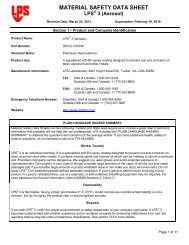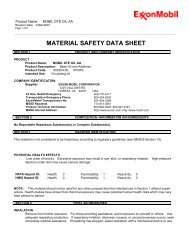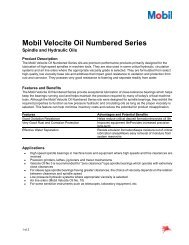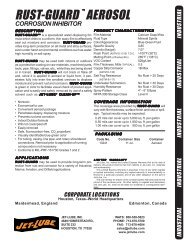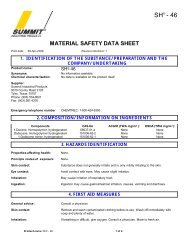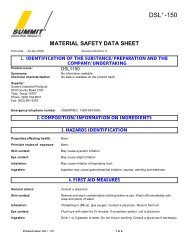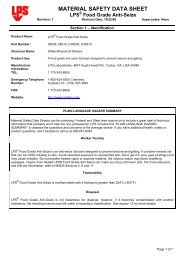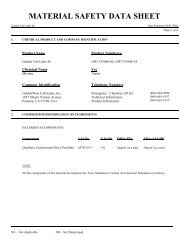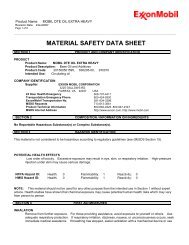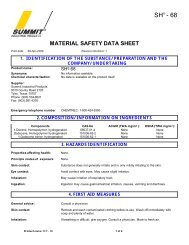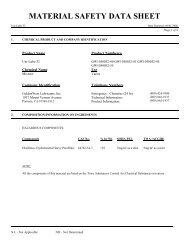Download HardCoat Corrosion Inhibitor Material Safety Data Sheet
Download HardCoat Corrosion Inhibitor Material Safety Data Sheet
Download HardCoat Corrosion Inhibitor Material Safety Data Sheet
Create successful ePaper yourself
Turn your PDF publications into a flip-book with our unique Google optimized e-Paper software.
MATERIAL SAFETY DATA SHEET<br />
LPS ® <strong>HardCoat</strong> (Bulk)<br />
Revision Date: 12/8/2010 Supercedes: 2/3/2009<br />
Section 1 • Product and Company Identification<br />
Product Name:<br />
Part Number:<br />
Chemical Name:<br />
Product Use:<br />
Manufacturer<br />
Information:<br />
LPS ® <strong>HardCoat</strong> (Bulk)<br />
03328, 03305, 03355, C03328,C03305,C03355<br />
Petroleum Hydrocarbon mixture<br />
A corrosion inhibitor designed to displace water and penetrate to form a barrier against<br />
moisture, air, acids, alkali fumes, and other corrosive elements on metals parts.<br />
LPS Laboratories, 4647 Hugh Howell Rd., Tucker, GA, USA 30084<br />
TEL: USA & Canada: 1 800 241-8334Outside USA and Canada 1 770-243-8800<br />
FAX: USA & Canada: 1 800 543-1563<br />
Outside USA and Canada 1 770-243-8899<br />
Emergency Telephone<br />
Number:<br />
Website:<br />
Chemtrec: USA&Canada 1-800-424-9300<br />
Outside USA and Canada: +1 (703) 527-3887<br />
http://www.lpslabs.com<br />
PLAIN LANGUAGE HAZARD SUMMARY<br />
<strong>Material</strong> <strong>Safety</strong> <strong>Data</strong> <strong>Sheet</strong>s can be confusing. Federal and State laws require us to include a great deal of technical<br />
information that probably won’t help the non-professional. LPS includes this “PLAIN LANGUAGE HAZARD SUMMARY” to<br />
address the questions and concerns of the average worker. If you have additional health, safety or product questions,<br />
don’t hesitate to call us at 800/241-8334.<br />
Worker Toxicity<br />
LPS ® <strong>HardCoat</strong> <strong>Corrosion</strong> <strong>Inhibitor</strong> Bulk is an industrial chemical - a specialized coating designed to prevent rust and<br />
corrosion on steel, aluminum and other metals. It contains “mineral spirits” and mineral oil which can be irritating to skin at<br />
a minimum and if handled improperly can be dangerous. We suggest you wear gloves and avoid extended exposure to<br />
unprotected skin. Don’t get it in your eyes (it stings), or breath large amounts of the vapor, (it will dry out your nasal<br />
passages and if you breathe large amounts in poorly ventilated areas it can make you dizzy and even sick). Do not use<br />
LPS ® <strong>HardCoat</strong> <strong>Corrosion</strong> <strong>Inhibitor</strong> Bulk for extended periods without adequate ventilation. If you’re going to perform work<br />
involving a lot of product in a poorly ventilated area, use of a respirator or self-contained breathing equipment may be<br />
required. For more exposure and first aid information, refer to MSDS Sections 2, 8 and 11.<br />
Flammability<br />
LPS ® <strong>HardCoat</strong> <strong>Corrosion</strong> <strong>Inhibitor</strong> Bulk is combustible, having a flash point above 100 o F and an auto ignition temperature<br />
over 400° F. Under normal use conditions flammability isn’t a concern, but don’t spray the product onto red-hot metal<br />
surfaces.<br />
Disposal<br />
If you spill LPS HARDCOAT CORROSION INHIBITOR, notify the proper environmental or safety department at your<br />
company right away. If LPS HARDCOAT CORROSION INHIBITOR becomes contaminated with another substance and is<br />
rendered unusable for protecting metal items from rust, the resulting mixture may fall under a hazardous classification.<br />
See section 13 for more details.<br />
Page 1 of 9
MATERIAL SAFETY DATA SHEET<br />
LPS ® <strong>HardCoat</strong> (Bulk)<br />
Revision Date: 12/8/2010 Supercedes: 2/3/2009<br />
Section 2 • Hazards Identification<br />
This material is considered hazardous by the OSHA Hazard Communication Standard (29 CFR 1910.1200).<br />
This product has been classified in accordance with the hazard criteria of the Controlled Products Regulations and the<br />
MSDS contains all the information required by the Controlled Products Regulations.<br />
Emergency Overview:<br />
Aerosol: Not applicable<br />
Bulk: DANGER: Combustible. Harmful or Fatal if Swallowed.<br />
Primary route(s) of entry: Skin and Eye contact. Inhalation.<br />
Potential Acute Health Effects:<br />
Eyes<br />
Skin<br />
Inhalation:<br />
Ingestion:<br />
Irritating to eyes<br />
Repeated exposure may cause skin dryness or cracking. The solvent portion of this product can also be<br />
absorbed through the skin and produce CNS depression effects.<br />
Excessive inhalation of vapors can cause irritation of the respiratory tract, nausea, dizziness or headache.<br />
In extreme cases (overexposure in a confined space for example), the vapors of the solvent portion can<br />
cause disorientation, difficulty with breathing, unconsciousness, and other effects depending upon the<br />
level of overexposure and duration.<br />
This product has a low order of acute oral toxicity, but ingestion of large quantities will cause central<br />
nervous system depression and gastrointestinal irritation. Symptoms include a burning sensation to the<br />
mouth and esophagus, nausea, vomiting, dizziness, staggering gait, drowsiness, loss of consciousness,<br />
and other central nervous system effects. May cause injury if aspirated into lungs.<br />
Potential Chronic Health Effects:<br />
Carcinogenic Effects: NTP: No IARC: No OSHA: No ACGIH: No<br />
Mutagenic Effects: None<br />
Teratogenic Effects: None<br />
Target Organs: None<br />
Medical conditions aggravated by exposure: Persons with pre-existing central nervous system (CNS) disease,<br />
neurological conditions, skin disorders, chronic respiratory diseases, or impaired liver or kidney function should avoid<br />
exposure.<br />
Signs and Symptoms<br />
Stinging in eyes. Repeated or prolonged skin contact can cause redness, irritation, and scaling of the skin (dermatitis).<br />
Breathing of high vapor concentrations may cause headaches, stupor, irritation of throat and eyes, and kidney effects.<br />
Page 2 of 9
MATERIAL SAFETY DATA SHEET<br />
LPS ® <strong>HardCoat</strong> (Bulk)<br />
Revision Date: 12/8/2010 Supercedes: 2/3/2009<br />
Section 3 • Composition / Information on Ingredients<br />
Component CASRN Weight Percent<br />
Mineral Spirits 8052-41-3/64742-88-7 40 - 50%<br />
Distillates Petroleum Hydrotreated Heavy Paraffinic 64742-54-7 5 - 10%<br />
Dipropylene Glycol Monomethyl Ether 34590-94-8 1 - 5%<br />
Any remaining ingredients are not classified as hazardous per 29 CFR 1910.1200 Subpart Z.<br />
Section 4 • First Aid Measures<br />
Eyes:<br />
Skin:<br />
Inhalation:<br />
Ingestion:<br />
Check for and remove contact lenses. If irritation or redness develops, flush eyes with cool, clean, lowpressure<br />
water for at least 15 minutes. Hold eyelids apart to ensure complete irrigation of the eye and<br />
eyelid tissue. Do not use eye ointment. Seek medical attention immediately.<br />
Remove contaminated shoes and clothing. Clean affected area thoroughly with mild soap and water. Do<br />
not use ointments. Seek medical attention if irritation persists.<br />
Immediately move victim to fresh air. If victim is not breathing, immediately begin rescue breathing. If<br />
heart has stopped, immediately begin cardiopulmonary resuscitation (CPR). If breathing is difficult, seek<br />
medical attention immediately.<br />
Do NOT induce vomiting unless directed to do so by medical personnel. Never give anything by mouth to<br />
an unconscious person. If spontaneous vomiting is about to occur, place victim’s head below knees. If<br />
victim is drowsy or unconscious, place on the left side with head down. Do not leave victim unattended.<br />
Seek medical attention immediately.<br />
Section 5 • Fire Fighting Measures<br />
Products of Combustion: Carbon monoxide and carbon dioxide.<br />
General Fire Hazards: High heat will cause product to boil, evolving vapor that could cause explosive rupture of closed<br />
containers<br />
Firefighting media: SMALL FIRE: Use Dry chemical powder.<br />
LARGE FIRE: Use CO 2 , DRY chemical powder, water spray, fog or foam. Cool containing<br />
vessels with water jet in order to prevent pressure build-up, auto ignition or explosions.<br />
Sensitivity to Impact: None. Sensitivity to Static Discharge: Yes<br />
Protection Clothing (Fire): Firefighters must use full bunker gear including NIOSH-approved positive pressure selfcontained<br />
breathing apparatus to protect against potential hazardous combustion or decomposition products and oxygen<br />
deficiencies. Evacuate area and fight the fire from a maximum distance or use unmanned hose holders or monitor<br />
nozzles.<br />
Special Remarks on Explosion Hazards: Apply water to containers to keep them cool. Heated containers will burst.<br />
Page 3 of 9
MATERIAL SAFETY DATA SHEET<br />
LPS ® <strong>HardCoat</strong> (Bulk)<br />
Revision Date: 12/8/2010 Supercedes: 2/3/2009<br />
Section 6 • Accidental Release Measures<br />
Containment<br />
Procedures<br />
Small Spill and Leak:<br />
Large Spill and Leak:<br />
Eliminate all ignition sources. Absorb with an inert material and<br />
dispose of properly.<br />
Eliminate all ignition sources. Secure the area and control<br />
access. Dike far ahead of a liquid spill to ensure complete<br />
collection. Pick up free liquid for disposal using absorbent<br />
pads, sand, or other inert non-combustible absorbent<br />
materials. Place into appropriate waste containers for later<br />
disposal.<br />
Clean-Up Procedures<br />
Evacuation<br />
Procedures<br />
Special Procedures<br />
Recover free product and place in suitable container for disposal.<br />
Ventilate area of leak or spill. Keep unnecessary and unprotected people away.<br />
Remove all sources of ignition. Ventilate area. Wear appropriate protective equipment during<br />
cleanup.<br />
Section 7 • Handling and Storage<br />
Handling: Eliminate ignition sources. Avoid contact with eyes, skin and clothing. Wear appropriate protective equipment<br />
during handling. Keep container closed. Do not breathe vapors or mists. Use only with adequate ventilation. Wash<br />
thoroughly after handling.<br />
Storage: Keep container in a cool, well-ventilated area. Avoid all sources of ignition (spark or flame). Store below 100°F.<br />
Precautions to be taken in handling and storage: Store all materials in dry, well-ventilated area. Avoid breathing<br />
vapors.<br />
Exposure Guidelines:<br />
Section 8 • Exposure Controls / Personal Protection<br />
Component<br />
CASRN<br />
OSHA<br />
TWA-PEL<br />
OSHA STEL<br />
ACGIH-TLV<br />
ACGIH-<br />
STEL<br />
NIOSH<br />
Mineral Spirits<br />
8052-41-3<br />
64742-88-7<br />
500 ppm Not<br />
2900 mg/m 3 Established<br />
100 ppm Not<br />
525 mg/m 3 Established<br />
350 mg/m3<br />
10-hr TWA<br />
1800 mg/m3<br />
15-min Ceiling<br />
Distillates Petroleum<br />
Hydrotreated Heavy Paraffinic<br />
64742-54-7<br />
5 mg/m 3<br />
(Oil Mist)*<br />
Not<br />
Established<br />
5 mg/m 3<br />
(Oil Mist)*<br />
Not<br />
Established<br />
Not Established<br />
Dipropylene Glycol Methyl Ether 34590-94-8 100 ppm<br />
* Supplier Recommendation<br />
Not<br />
Established<br />
100 ppm 150 ppm 100 ppm<br />
Page 4 of 9
MATERIAL SAFETY DATA SHEET<br />
LPS ® <strong>HardCoat</strong> (Bulk)<br />
Revision Date: 12/8/2010 Supercedes: 2/3/2009<br />
Engineering Controls: Provide general and/or local exhaust ventilation to keep exposures below the exposure guidelines<br />
listed above.<br />
Personal Protection:<br />
Eye protection<br />
Hand protection<br />
Respiratory protection<br />
General Hygiene<br />
Considerations<br />
<strong>Safety</strong> glasses with side shields conforming to appropriate regulations. Where there is<br />
reasonable probablity of liquid contact, wear splash-proof goggles. Eye wash fountain and<br />
emergency shower facilities are recommended.<br />
Normally no hand protection is required; however, if product can get on skin during use, use<br />
chemical resistant gloves (i.e., solvent resistant laminate film type Anselll LCP ® ) conforming to<br />
appropriate regulations. Please observe the instructions regarding permeability and<br />
breakthrough time that are provided by the supplier of the gloves.<br />
Typical use of this product under normal conditions does not require the use of respiratory<br />
protection. If airborne concentrations are above the applicable exposure limits (listed above),<br />
use NIOSH approved respiratory protection (i.e., organic vapor cartridge).<br />
Wash throughly after handling. Have eye-wash facilities immediately available.<br />
Section 9 – Physical and Chemical Properties<br />
Appearance: Viscous liquid. Color: Medium to dark brown<br />
Odor: Cherry Evaporation Rate: 0.2(BuAc=1)<br />
Solubility Description: Not soluble Flash Point: > 42°C (107° F)<br />
Boiling Point: 160°C (320°F) Flash Point Method: TCC<br />
Specific Gravity<br />
(H2O=1):<br />
0.87-0.89 @ 20ºC Decomposition Temperature: Not Established<br />
Vapor Density (air = 1): 4.8 Auto ignition temperature: >230°C (446°F)<br />
Vapor Pressure: 2.6 mmHg (at 20°C) Flammable limits (estimated): LOWER: N.E.<br />
UPPER: N.E.<br />
Rule 1171 PPc: Not Applicable Partition Coefficient<br />
(octanol/water):<br />
Not Established<br />
V.O.C. Content: Aerosol: Not Applicable Odor Threshold: Not Established<br />
Bulk: 51.4%,3.8#/gal,451g/L<br />
per CARB/OTC/EPA<br />
Melting Point: Not Established Viscosity: 30.6 – 37.4 cSt @25°C<br />
pH: Not Applicable Volatiles: 50-60%<br />
Heat of combustion:<br />
Not Established<br />
Page 5 of 9
MATERIAL SAFETY DATA SHEET<br />
LPS ® <strong>HardCoat</strong> (Bulk)<br />
Revision Date: 12/8/2010 Supercedes: 2/3/2009<br />
Section 10 • Stability and Reactivity<br />
Chemical Stability:<br />
Conditions to Avoid:<br />
Incompatibility:<br />
Hazardous Decomposition:<br />
Product is stable under recommended storage conditions.<br />
Keep away from heat and ignition sources.<br />
Reactive or incompatible with oxidizing agents.<br />
These products are carbon oxides (CO, CO2).<br />
Hazardous Polymerization:<br />
Will not occur.<br />
Section 11 • Toxicological Information<br />
Acute and Chronic Toxicity<br />
A: General Product Information<br />
An acute toxicity study of this product has not been conducted. Information given in this section relates only to individual<br />
constituents contained in this preparation.<br />
B: Component Analysis<br />
Ingredients CASRN LC-50 LD-50<br />
Mineral Spirits<br />
8052-41-3<br />
64742-88-7<br />
>5500 mg/m 3 /rat/4hr<br />
>5000 mg/kg/oral/rat<br />
>3000 mg/kg/dermal/rat<br />
Distillates Petroleum Hydrotreated<br />
Heavy Paraffinic<br />
64742-54-7 Not established Not established<br />
Dipropylene Glycol Methyl Ether 34590-94-8 16000 ppm/rat/4hr*<br />
5800 mg/kg/oral/rat*<br />
20000 mg/kg/dermal/rabbit<br />
Page 6 of 9
MATERIAL SAFETY DATA SHEET<br />
LPS ® <strong>HardCoat</strong> (Bulk)<br />
Revision Date: 12/8/2010 Supercedes: 2/3/2009<br />
Section 12 • Ecological Information<br />
Mobility:<br />
Semi-volatile. Readily absorbed into<br />
soil.<br />
Persistence and<br />
degradability:<br />
Not readily biodegradable.<br />
Bioaccumulative<br />
potential:<br />
No bioaccumulation potential Other adverse effects: See below **<br />
Ecotoxicology:<br />
Effect on Organisms Component CASRN Test Species Results<br />
Acute Toxicity on Fishes<br />
Mineral Spirits<br />
Distillates Petroleum<br />
Hydrotreated Heavy<br />
8052-41-3<br />
64742-88-7<br />
96 hour-LC 50<br />
64742-54-7 96 hour-LC 50<br />
Fathead<br />
Minnow<br />
Oncorhynchus<br />
mykiss<br />
800 mg/L<br />
> 1000 mg/L<br />
Acute Toxicity on Daphnia<br />
Mineral Spirits<br />
8052-41-3<br />
64742-88-7<br />
48 hour-LC 50 Daphnia Magna >100 mg/L<br />
Bacterial inhibition<br />
No <strong>Data</strong> Available<br />
Growth inhibition of algae<br />
Mineral Spirits<br />
8052-41-3<br />
64742-88-7<br />
96 hour-EC 50 Algae 450 mg/L<br />
Bioaccumulation in fish<br />
No <strong>Data</strong> Available<br />
**If spilled, the 64742-54-7 constituent may kill grasses and small plants by interfering with transpiration. Spilled material<br />
may coat gill structures of fish resulting in suffocation if spilled in shallow, running water. This product may be toxic to<br />
amphibians by preventing dermal respiration. This product may also cause gastrointestinal distress to birds and mammals<br />
through ingestion.<br />
Section 13 • Disposal Considerations<br />
Waste Status:<br />
Disposal:<br />
Note:<br />
This product has the RCRA characteristic of ignitability and if discarded would have the hazardous<br />
waste code D001.<br />
Waste must be disposed of in accordance with federal, state and local environmental control<br />
regulations.<br />
Chemical additions to, processing of, or otherwise altering this material may make this waste<br />
management information inaccurate, incomplete, or otherwise inappropriate. Furthermore, state and<br />
local waste disposal requirements may be more restrictive than federal laws and regulations.<br />
Page 7 of 9
MATERIAL SAFETY DATA SHEET<br />
LPS ® <strong>HardCoat</strong> (Bulk)<br />
Revision Date: 12/8/2010 Supercedes: 2/3/2009<br />
Section 14 • Transport Information<br />
D.O.T. Ground<br />
Shipping Name: Not Regulated UN Number: NA<br />
Hazard Class: NA Technical Name: NA<br />
Subclass: NA Hazard Label: NA<br />
Road/Rail -<br />
ADR/RID<br />
UN no: 1139 ADR Class: 3<br />
Packing group:<br />
Name and<br />
Description:<br />
III<br />
Classification<br />
code:<br />
Coating Solution Hazard ID no: 30<br />
Labeling: 3 Technical Name: NA<br />
F1<br />
UN no: 1139 Class: 3<br />
Shipping Name: Coating Solution Subsidiary Risk: NA<br />
IMDG-IMO<br />
Labeling: 3 Packing group: III<br />
Packing<br />
Instructions:<br />
P001, LP01 EmS: F-E, S-E<br />
Marine pollutant: N0 Technical Name: NA<br />
UN no: 1139 Class: 3<br />
IATA-ICAO<br />
Shipping Name: Coating Solution Subclass NA<br />
Packing<br />
instructions:<br />
Labeling:<br />
309, Y309 Packing group: III<br />
Flammable Liquid<br />
Section 15 • Regulatory information<br />
U.S. Federal Regulations<br />
RCRA Hazardous Waste No.: D001<br />
Comprehensive Environmental Response and Liability Act of 1980 (CERCLA): None<br />
Toxic Substances Control Act (TSCA):<br />
All components of this product are TSCA inventory listed and/or are exempt.<br />
Superfund Amendments and Reauthorization Act (SARA) Title III<br />
SARA Section 311/312 (40 CFR 370) Hazard Categories:<br />
Fire Hazard, Immediate (Acute) Health Hazard, Delayed (Chronic) Health Hazard<br />
This product contains the following toxic chemical(s) subject to reporting requirements of SARA Section 313<br />
(40 CFR 372): No individual section 313 component is present at or above 1%<br />
Section 112 Hazardous Air Pollutants (HAPs): None<br />
Page 8 of 9
MATERIAL SAFETY DATA SHEET<br />
LPS ® <strong>HardCoat</strong> (Bulk)<br />
Revision Date: 12/8/2010 Supercedes: 2/3/2009<br />
State Regulations<br />
New Jersey Right to Know:<br />
Aerosol: Not Applicable<br />
Bulk: Mineral Spirits 8052-41-3/64742-88-7 ● Aromatic Hydrocarbon Resin 68410-16-5 ● Distillates Petroleum,<br />
Hydrotreated Heavy Paraffinic 64742-54-7 ● Petrolatum 8009-03-8 ● Hydrotreated Microcrystalline Wax 64742-60-5 ●<br />
Dipropylene Glycol Methyl Ether 34590-94-8<br />
California: This product does not contain chemical(s) known to the State of California to cause cancer, birth defects or<br />
reproductive harm.<br />
California and OTC States: This product is not regulated.<br />
International Regulations<br />
Canadian Environmental Protection Act: All of the components of this product are included on the Canadian Domestic<br />
Substances list (DSL).<br />
Canadian Workplace Hazardous <strong>Material</strong>s Information System (WHMIS):<br />
This product has been classified in accordance with the hazard criteria of the Controlled Products Regulations and the<br />
MSDS contains all the information required by the Controlled Products Regulations.<br />
WHMIS Classification: Bulk<br />
Class B3, Class D2B<br />
Other Regulations<br />
Montreal Protocol listed ingredients:<br />
Stockholm Convention listed ingredients:<br />
Rotterdam Convention listed ingredients:<br />
RoHS Compliant:<br />
None<br />
None<br />
None<br />
Yes<br />
Section 16 • Other Information<br />
MSDS# 13328<br />
Responsible Name:<br />
Clea George<br />
Regulatory Affairs Coordinator<br />
HMIS 1996 HMIS III NFPA<br />
Health: 1 Health: [/]1<br />
Flammability: aerosol N.A.<br />
Flammability: 2<br />
Flammability: bulk 2<br />
2<br />
Physical Hazard:<br />
Health<br />
1<br />
0<br />
N.A.<br />
Reactivity: 0 aerosol<br />
0<br />
Physical Hazard: bulk 0<br />
Flammability<br />
Reactivity<br />
Notice to Reader:<br />
To the best of our knowledge, the information contained herein is accurate. However, neither the above named supplier nor<br />
any of its subsidiaries assumes any liability whatsoever for the accuracy or completeness of the information contained<br />
herein. Final determination of suitability of any material is the sole responsibility of the user. All materials may present<br />
unknown hazards and should be used with caution. Although certain hazards are described herein, we cannot guarantee<br />
that these are the only hazards that exist.<br />
Clea George, Regulatory Affairs Coordinator<br />
LPS Laboratories, A division of Illinois Tool Works<br />
Page 9 of 9


